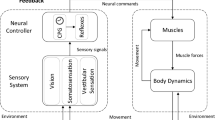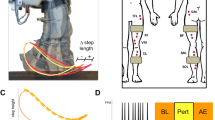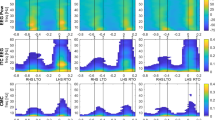Abstract
Different neural contributions to motor learning might be involved when different error sizes of perturbation are introduced. Although the corticospinal drive contributes to abrupt gait adaptation processes, no studies have investigated whether cortical involvement during gait differs between perturbations applied abruptly and gradually. This study aimed to investigate the differences in oscillatory common neural drives to ankle muscles during gait between abrupt and gradual adaptations, using coherence analyses of paired surface electromyographic (EMG) recordings. Sixteen healthy young adults performed the treadmill gait with perturbation resisting forward movement of the swing leg for 10 min under two conditions: abrupt (a large perturbation from the beginning of the adaptation period) and gradual (a series of small perturbations that gradually increased). Swing phase duration and step length showed significantly greater asymmetry in the abrupt condition than in the gradual condition in the early adaptation period (p < 0.01), despite no significant differences in gait symmetries between the two conditions in the early post-adaptation period. EMG–EMG coherence calculated from the tibialis anterior muscle in the beta band (15–35 Hz) on the perturbed side was significantly higher in the early adaptation period in the abrupt condition (p < 0.05), but not in the gradual condition. There were significant relationships between changes in temporal gait symmetry and EMG–EMG coherence during the different adaptation periods between the two conditions (p < 0.05). The abrupt large perturbation seems to require a cortical involvement, whereas a gradual adaptation with small gait asymmetry requires no modulation of cortical involvement.






Similar content being viewed by others
Data availability
The data in this study will be made available upon reasonable request to the corresponding author.
References
Alcantara CC, Charalambous CC, Morton SM, Russo TL, Reisman DS (2018) Different error size during locomotor adaptation affects transfer to overground walking poststroke. Neurorehabil Neural Repair 32:1020–1030
Artoni F, Fanciullacci C, Bertolucci F, Panarese A, Makeig S, Micera S, Chisari C (2017) Unidirectional brain to muscle connectivity reveals motor cortex control of leg muscles during stereotyped walking. Neuroimage 159:403–416
Barthelemy D, Willerslev-Olsen M, Lundell H, Conway BA, Knudsen H, Biering-Sorensen F, Nielsen JB (2010) Impaired transmission in the corticospinal tract and gait disability in spinal cord injured persons. J Neurophysiol 104:1167–1176
Barthelemy D, Alain S, Grey MJ, Nielsen JB, Bouyer LJ (2012) Rapid changes in corticospinal excitability during force field adaptation of human walking. Exp Brain Res 217:99–115
Barthelemy D, Willerslev-Olsen M, Lundell H, Biering-Sorensen F, Nielsen JB (2015) Assessment of transmission in specific descending pathways in relation to gait and balance following spinal cord injury. Prog Brain Res 218:79–101
Bretzner F, Drew T (2005) Contribution of the motor cortex to the structure and the timing of hindlimb locomotion in the cat: a microstimulation study. J Neurophysiol 94(1):657–672
Brouwer B, Ashby P (1992) Corticospinal projections to lower limb motoneurons in man. Exp Brain Res 89(3):649–654
Bulea TC, Stanley CJ, Damiano DL (2017) Part 2: adaptation of gait kinematics in unilateral cerebral palsy demonstrates preserved independent neural control of each limb. Front Hum Neurosci 11:50
Chapman JP, Chapman LJ, Allen JJ (1987) The measurement of foot preference. Neuropsychologia 25(3):579–584
Choi JT, Vining EP, Reisman DS, Bastian AJ (2009) Walking flexibility after hemispherectomy: split-belt treadmill adaptation and feedback control. Brain 132(Pt 3):722–733
Choi JT, Bouyer LJ, Nielsen JB (2015) Disruption of locomotor adaptation with repetitive transcranial magnetic stimulation over the motor cortex. Cereb Cortex 25:1981–1986
Criscimagna-Hemminger SE, Bastian AJ, Shadmehr R (2010) Size of error affects cerebellar contributions to motor learning. J Neurophysiol 103:2275–2284
Damiano DL, Stanley CJ, Bulea TC, Park HS (2017) Motor learning abilities are similar in hemiplegic cerebral palsy compared to controls as assessed by adaptation to unilateral leg-weighting during gait: part I. Front Hum Neurosci 11:49
Day KA, Leech KA, Roemmich RT, Bastian AJ (2018) Accelerating locomotor savings in learning: compressing four training days to one. J Neurophysiol 119:2100–2113
Dietz V (2002) Proprioception and locomotor disorders. Nat Rev Neurosci 3(10):781–790
Dietz V (2003) Spinal cord pattern generators for locomotion. Clin Neurophysiol 114(8):1379–1389
Drew T, Marigold DS (2015) Taking the next step: cortical contributions to the control of locomotion. Curr Opin Neurobiol 33:25–33
Farmer SF, Bremner FD, Halliday DM, Rosenberg JR, Stephens JA (1993) The frequency content of common synaptic inputs to motoneurones studied during voluntary isometric contraction in man. J Physiol 470:127–155
Grosse P, Cassidy MJ, Brown P (2002) EEG–EMG, MEG–EMG and EMG–EMG frequency analysis: physiological principles and clinical applications. Clin Neurophysiol 113:1523–1531
Halliday DM, Rosenberg JR, Amjad AM, Breeze P, Conway BA, Farmer SF (1995) A framework for the analysis of mixed time series/point process data–theory and application to the study of physiological tremor, single motor unit discharges and electromyograms. Prog Biophys Mol Biol 64:237–278
Halliday DM, Conway BA, Christensen LO, Hansen NL, Petersen NP, Nielsen JB (2003) Functional coupling of motor units is modulated during walking in human subjects. J Neurophysiol 89:960–968
Hansen NL, Conway BA, Halliday DM, Hansen S, Pyndt HS, Biering-Sorensen F, Nielsen JB (2005) Reduction of common synaptic drive to ankle dorsiflexor motoneurons during walking in patients with spinal cord lesion. J Neurophysiol 94:934–942
Hinton DC, Conradsson DM, Paquette C (2020) Understanding human neural control of short-term gait adaptation to the split-belt treadmill. Neuroscience 451:36–50
Hussain SJ, Morton SM (2014) Perturbation schedule does not alter retention of a locomotor adaptation across days. J Neurophysiol 111:2414–2422
Jayaram G, Galea JM, Bastian AJ, Celnik P (2011) Human locomotor adaptive learning is proportional to depression of cerebellar excitability. Cereb Cortex 21:1901–1909
Jayaram G, Tang B, Pallegadda R, Vasudevan EV, Celnik P, Bastian A (2012) Modulating locomotor adaptation with cerebellar stimulation. J Neurophysiol 107:2950–2957
Jensen P, Jensen NJ, Terkildsen CU, Choi JT, Nielsen JB, Geertsen SS (2018) Increased central common drive to ankle plantar flexor and dorsiflexor muscles during visually guided gait. Physiol Rep 6:e13598
Kattla S, Lowery MM (2010) Fatigue related changes in electromyographic coherence between synergistic hand muscles. Exp Brain Res 202(1):89–99
Kitatani R, Ohata K, Aga Y, Mashima Y, Hashiguchi Y, Wakida M, Maeda A, Yamada S (2016) Descending neural drives to ankle muscles during gait and their relationships with clinical functions in patients after stroke. Clin Neurophysiol 127:1512–1520
Kitatani R, Koganemaru S, Maeda A, Mikami Y, Matsuhashi M, Mima T, Yamada S (2020) Gait-combined transcranial alternating current stimulation modulates cortical control of muscle activities during gait. Eur J Neurosci 52:4791–4802
Krakauer JW, Hadjiosif AM, Xu J, Wong AL, Haith AM (2019) Motor learning. Compr Physiol 9(2):613–663
Lam T, Anderschitz M, Dietz V (2006) Contribution of feedback and feedforward strategies to locomotor adaptations. J Neurophysiol 95(2):766–773
Larsen LH, Jensen T, Christensen MS, Lundbye-Jensen J, Langberg H, Nielsen JB (2016) Changes in corticospinal drive to spinal motoneurones following tablet-based practice of manual dexterity. Physiol Rep 4:e12684
Lin JT, Hsu CJ, Dee W, Chen D, Rymer WZ, Wu M (2019) Error variability affects the after effects following motor learning of lateral balance control during walking in people with spinal cord injury. Eur J Neurosci 50:3221–3234
Morton SM, Bastian AJ (2006) Cerebellar contributions to locomotor adaptations during splitbelt treadmill walking. J Neurosci 26:9107–9116
Nielsen JB, Brittain JS, Halliday DM, Marchand-Pauvert V, Mazevet D, Conway BA (2008) Reduction of common motoneuronal drive on the affected side during walking in hemiplegic stroke patients. Clin Neurophysiol 119:2813–2818
Nishimura Y, Morichika Y, Isa T (2009) A subcortical oscillatory network contributes to recovery of hand dexterity after spinal cord injury. Brain 132(Pt 3):709–721
Orban de Xivry JJ, Criscimagna-Hemminger SE, Shadmehr R (2011) Contributions of the motor cortex to adaptive control of reaching depend on the perturbation schedule. Cereb Cortex 21:1475–1484
Orban de Xivry JJ, Ahmadi-Pajouh MA, Harran MD, Salimpour Y, Shadmehr R (2013) Changes in corticospinal excitability during reach adaptation in force fields. J Neurophysiol 109:124–136
Oshima A, Wakahara T, Nakamura Y, Tsujiuchi N, Kamibayashi K (2021) Time-series changes in intramuscular coherence associated with split-belt treadmill adaptation in humans. Exp Brain Res 239(7):2127–2139
Park SH, Hsu CJ, Dee W, Roth EJ, Rymer WZ, Wu M (2021) Gradual adaptation to pelvis perturbation during walking reinforces motor learning of weight shift toward the paretic side in individuals post-stroke. Exp Brain Res 239(6):1701–1713
Petersen TH, Willerslev-Olsen M, Conway BA, Nielsen JB (2012) The motor cortex drives the muscles during walking in human subjects. J Physiol 590:2443–2452
Petersen TH, Farmer SF, Kliim-Due M, Nielsen JB (2013) Failure of normal development of central drive to ankle dorsiflexors relates to gait deficits in children with cerebral palsy. J Neurophysiol 109:625–639
Power HA, Norton JA, Porter CL, Doyle Z, Hui I, Chan KM (2006) Transcranial direct current stimulation of the primary motor cortex affects cortical drive to human musculature as assessed by intermuscular coherence. J Physiol 577:795–803
Reinking MF, Dugan L, Ripple N, Schleper K, Scholz H, Spadino J, Stahl C, McPoil TG (2018) Reliability of two-dimensional video-based running gait analysis. Int J Sports Phys Ther 13:453–461
Reisman DS, Block HJ, Bastian AJ (2005) Interlimb coordination during locomotion: what can be adapted and stored? J Neurophysiol 94:2403–2415
Reisman DS, Wityk R, Silver K, Bastian AJ (2007) Locomotor adaptation on a split-belt treadmill can improve walking symmetry post-stroke. Brain 130:1861–1872
Reisman DS, Bastian AJ, Morton SM (2010) Neurophysiologic and rehabilitation insights from the split-belt and other locomotor adaptation paradigms. Phys Ther 90:187–195
Roemmich RT, Bastian AJ (2015) Two ways to save a newly learned motor pattern. J Neurophysiol 113:3519–3530
Sato S, Choi JT (2019) Increased intramuscular coherence is associated with temporal gait symmetry during split-belt locomotor adaptation. J Neurophysiol 122:1097–1109
Sato S, Choi JT (2021) Neural control of human locomotor adaptation: lessons about changes with aging. Neuroscientist. https://doi.org/10.1177/10738584211013723
Savin DN, Tseng SC, Morton SM (2010) Bilateral adaptation during locomotion following a unilaterally applied resistance to swing in nondisabled adults. J Neurophysiol 104:3600–3611
Savin DN, Tseng SC, Whitall J, Morton SM (2013) Poststroke hemiparesis impairs the rate but not magnitude of adaptation of spatial and temporal locomotor features. Neurorehabil Neural Repair 27:24–34
Savin DN, Morton SM, Whitall J (2014) Generalization of improved step length symmetry from treadmill to overground walking in persons with stroke and hemiparesis. Clin Neurophysiol 125:1012–1020
Sawers A, Kelly VE, Hahn ME (2013) Effects of gradual versus sudden training on the cognitive demand required while learning a novel locomotor task. J Mot Behav 45:405–414
Schlerf JE, Galea JM, Bastian AJ, Celnik PA (2012) Dynamic modulation of cerebellar excitability for abrupt, but not gradual, visuomotor adaptation. J Neurosci 32:11610–11617
Schubert M, Curt A, Jensen L, Dietz V (1997) Corticospinal input in human gait: modulation of magnetically evoked motor responses. Exp Brain Res 115(2):234–246
Smith MA, Ghazizadeh A, Shadmehr R (2006) Interacting adaptive processes with different timescales underlie short-term motor learning. PLoS Biol 4(6):e179
Spedden ME, Choi JT, Nielsen JB, Geertsen SS (2019) Corticospinal control of normal and visually guided gait in healthy older and younger adults. Neurobiol Aging 78:29–41
Statton MA, Vazquez A, Morton SM, Vasudevan EVL, Bastian AJ (2018) Making sense of cerebellar contributions to perceptual and motor adaptation. Cerebellum 17:111–121
Tang R, Kim J, Gaebler-Spira DJ, Wu M (2019) Gradual increase of perturbation load induces a longer retention of locomotor adaptation in children with cerebral palsy. Hum Mov Sci 63:20–33
Torres-Oviedo G, Bastian AJ (2012) Natural error patterns enable transfer of motor learning to novel contexts. J Neurophysiol 107:346–356
van Asseldonk EH, Campfens SF, Verwer SJ, van Putten MJ, Stegeman DF (2014) Reliability and agreement of intramuscular coherence in tibialis anterior muscle. PLoS One 9:e88428
van Wijk BC, Beek PJ, Daffertshofer A (2012) Neural synchrony within the motor system: what have we learned so far? Front Hum Neurosci 6:252
Willerslev-Olsen M, Petersen TH, Farmer SF, Nielsen JB (2015) Gait training facilitates central drive to ankle dorsiflexors in children with cerebral palsy. Brain 138:589–603
Wu M, Hsu CJ, Kim J (2019) Forced use of paretic leg induced by constraining the non-paretic leg leads to motor learning in individuals post-stroke. Exp Brain Res 237(10):2691–2703
Yang JF, Lam T, Pang MY, Lamont E, Musselman K, Seinen E (2004) Infant stepping: a window to the behaviour of the human pattern generator for walking. Can J Physiol Pharmacol 82(8–9):662–674
Yang JF, Lamont EV, Pang MY (2005) Split-belt treadmill stepping in infants suggests autonomous pattern generators for the left and right leg in humans. J Neurosci 25(29):6869–6876
Zijlstra W, Hof AL (2003) Assessment of spatio-temporal gait parameters from trunk accelerations during human walking. Gait Posture 18:1–10
Acknowledgements
We would like to thank Editage (http://www.editage.jp) for English language editing.
Funding
This study was partially supported by Grants-in-Aid for Research Activity Start-up (17H06770) and Early-Career Scientists (19K19866 and 21K17455) from the Japan Society for the Promotion of Science.
Author information
Authors and Affiliations
Contributions
All authors have made significant contributions to this article. Specifically, RK, AM, JU, and SY contributed to the research design and manuscript writing, and RK, AM, and JU contributed to data collection and analysis. All authors approved the final version of the manuscript.
Corresponding author
Ethics declarations
Conflict of interest
The authors declare that they have no conflicts of interest.
Ethical approval
All procedures performed in this study were in accordance with the ethical standards of the institutional and/or national research committee and with the 1964 Declaration of Helsinki and its later amendments or comparable ethical standards. This study procedure was approved by the ethics committee of Kyoto University Graduate School and Faculty of Medicine (Approval No. R1348).
Consent to participate
Informed consent was obtained from all individual participants included in this study.
Consent for publication
The participants provided written informed consent for the use and publication of the data obtained in the experiments.
Additional information
Communicated by Winston D. Byblow.
Publisher's Note
Springer Nature remains neutral with regard to jurisdictional claims in published maps and institutional affiliations.
Rights and permissions
About this article
Cite this article
Kitatani, R., Maeda, A., Umehara, J. et al. Different modulation of oscillatory common neural drives to ankle muscles during abrupt and gradual gait adaptations. Exp Brain Res 240, 871–886 (2022). https://doi.org/10.1007/s00221-021-06294-3
Received:
Accepted:
Published:
Issue Date:
DOI: https://doi.org/10.1007/s00221-021-06294-3




